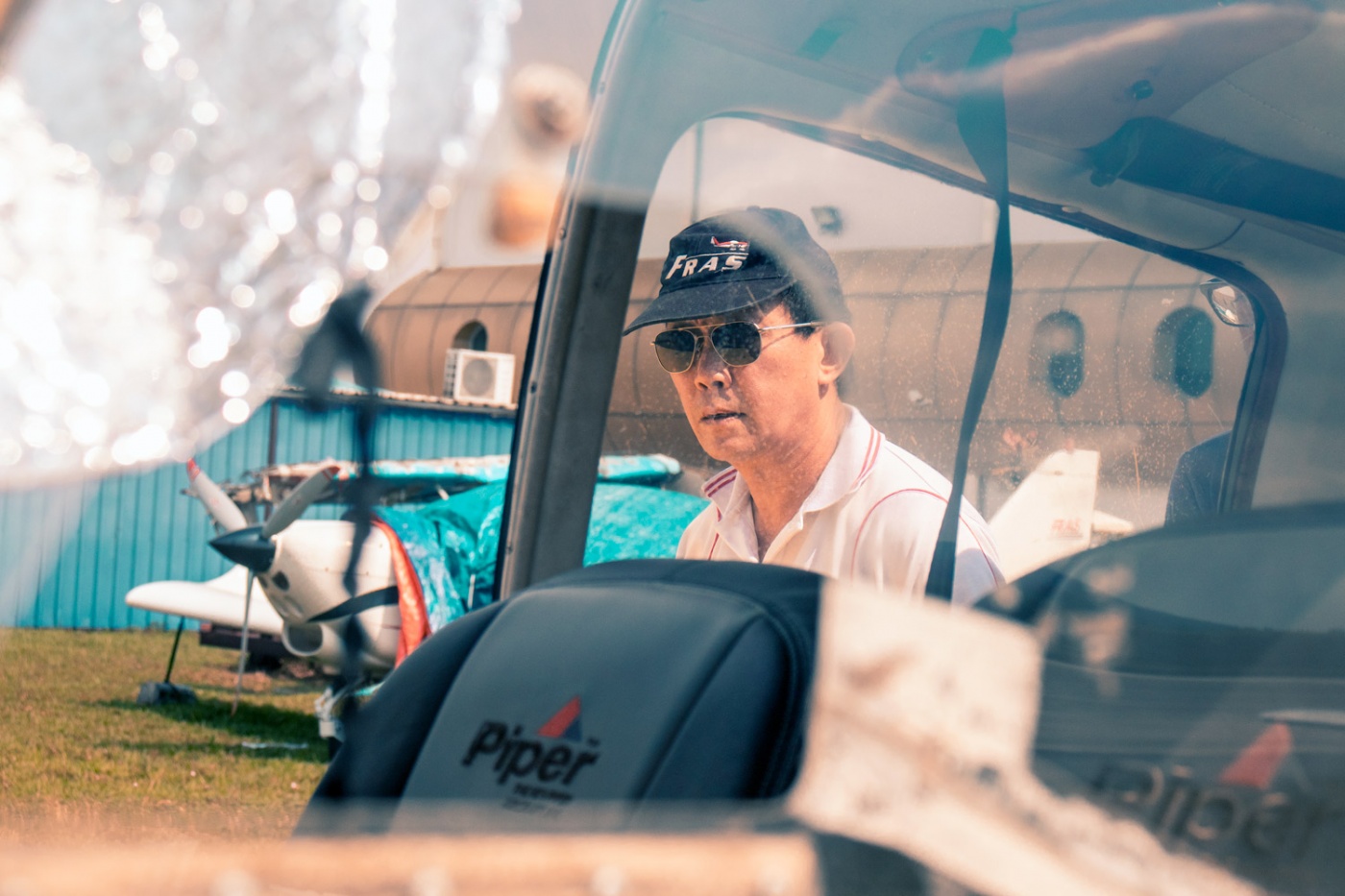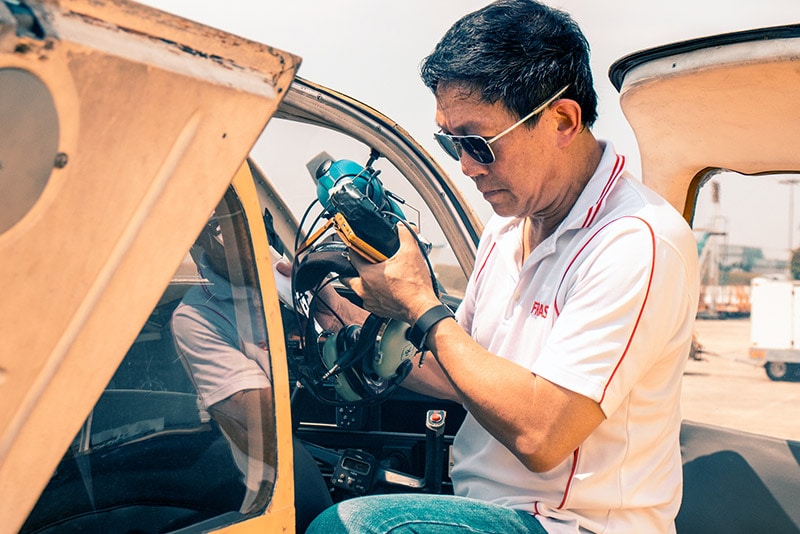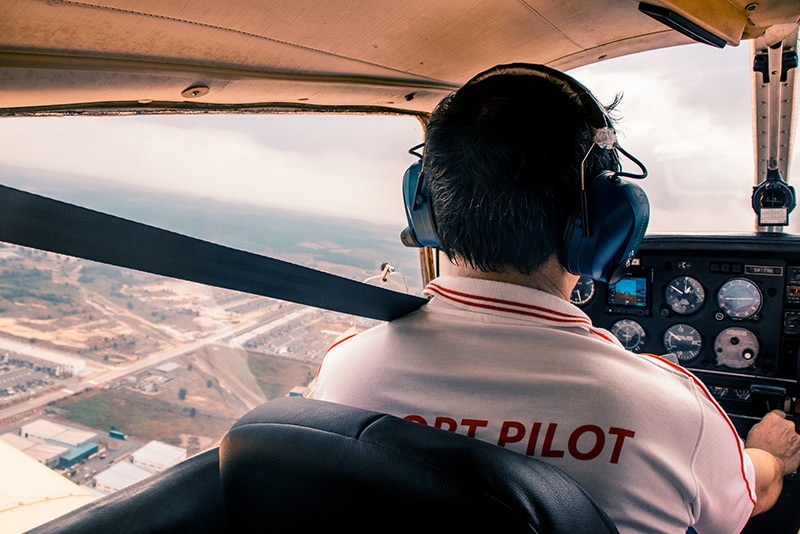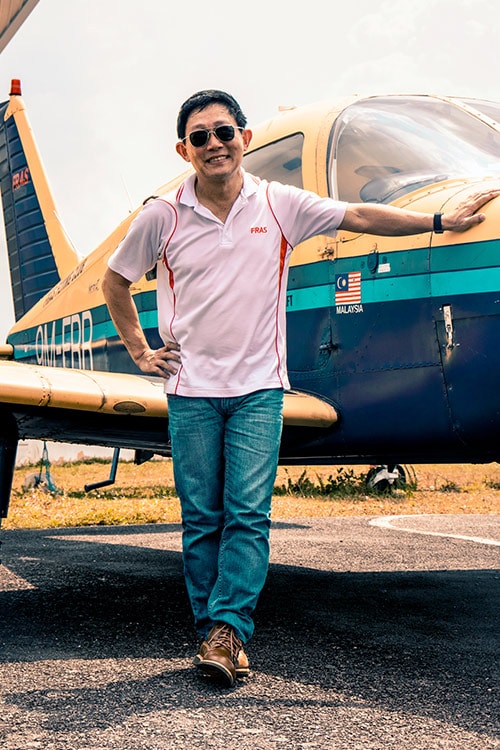Inside the Unusual Life of a Private Pilot in Singapore
Shadowing a private pilot for a day, we embark on a road trip to Malaysia for a crash course in aviation.
I’m flying 1,500 feet above the ground over Johor Bahru with a GrabHitch driver I met two years ago, and we’re all about to die… At least, that was what I was thinking as we went free falling for about half a second in a tiny, four-seater plane.
This story began in the summer of 2017, incidentally while I was working on the set of Crazy Rich Asians. Just as kismet brought me to the Hollywood set, it placed me in the front seat of a GrabHitch car I booked to get to an overnight shoot at Gardens by the Bay. It could’ve been anyone, but the driver turned out to be an ex-military, now-recreational pilot. Five days later, I texted my new acquaintance and saved his number.
Fast forward two years, Domingo Molina Jr arrives at my HDB block again in his silver sedan, but this time, he’s not accepting fees.
We’re taking a road trip to Malaysia, a week before his 60th birthday (though in person, the father of three grown children doesn’t look a day over 45). An uncommonly giving man, he has taken leave from his day job as the deputy centre manager of the Kinetics Driving Centre (one of many training centres under ST Engineering) just to give us a private plane ride, even offering to pay for our meals.
It’s clear he’s not in it for the money. Private pilots, by international regulations, aren’t allowed to charge their passengers. “We are governed by the International Civil Aviation Organization, which sets the rules for everything,” he says. Although, there are those who stray and rebel.
While he treats it merely as an alternative hobby now, taking to the air about once a month if time permits, the flying aficionado came close to being a full-time pilot while in the military. The dream took hold in secondary school, but it wasn’t until his time in college that he got the opportunity to enrol in the Youth Flying Club as a co-curricular activity (CCA).
It costs about $50,000 to get a private pilot license (PPL), but in school, everything was paid for—a privilege that made flying a much less expensive practice for Domingo. Nonetheless, unlike driving a car, it doesn’t stop at obtaining your recreational license. You need to clock at least five hours of training (or more) before you’re certified to fly a model you’re new to—and with that, comes additional fees as well.
“That’s because each aircraft behaves differently,” says Domingo. A Cessna plane, the most basic type of aircraft with a high wing that every beginner has to master, tends to float every time you try to land it. He adds, “It is very tolerant and forgiving. Even with engine failure, it’s able to glide down.” A Microlight plane, on the other hand, looks like a safety risk with its semi-open design. “This is like a motorcycle in the sky,” Domingo illustrates. “I had to go through about 30 hours of training to get a special license to fly this plane.”
Then, there’s the Piper aircraft—the plane that “wants to land”. Domingo’s favourite to fly with, this four-seater metal bird is what we’re driving to Johor Bahru for. Pulling into the Senai Airport Cargo Complex, we walk through an inconspicuous door, into the petite, artificially chilled office of the FRAS Flying Club, of which Domingo has been a member for ages.
It’s funny how ideas rarely sink in until you see it in writing. I scribble my mother’s name as my next-of-kin, the person to call if I break a bone or fall off the plane, my palms getting sweatier by the minute. A pithy briefing and a few nervous chuckles later, we’re off to the airfield. I put my shades on to hide the fear in my eyes.
They say flying is the safest way to travel, and you’d be convinced of that after witnessing the punctilious pre-flight preparations. First comes a series of external inspections of the plane, before Domingo hops in to go through another thorough checklist to ensure everything is in order. He then radioes the control tower for permission to start the engine. Once the machine starts rumbling, there’s yet another list of items to check. He goes through the list, gets permission to move to the side of the runway, does another round of checks, tells the control tower he’s ready for the runway, and waits for instructions before lining the aircraft up for takeoff.
“This procedure is the same for any aircraft, even commercial aircrafts. That’s why sometimes when you sit in an aeroplane, you find that it takes some time to take off. These things are happening,” he elucidates. Not to mention, you’ll have to renew your pilot’s license every year and take a medical test.
In spite of all this, I remain a confused mix of jittery and thrilled, stepping onto the right wing of the Piper PA-28 aircraft to get into the co-pilot’s seat—a place I, a recreational cyclist at best who failed to get past her third driving lesson, feel utterly unworthy of. A momentary snag in turning on the ignition didn’t help assuage my anxiety either.
My right brain geeks out over the bells and whistles of the old-school plane, while listening in on the conversation between the pilot and the control tower for the first time, which sounds as official as it is indecipherable to the untrained ear.
My left brain, on the other hand, is preoccupied with remembering what captain Gurcharan Singh, the founder of the FRAS Flying Club, told me back in the office: Don’t hold the handles too tightly. Pull it to bring the plane up. Push it to bring the plane down. To go right or left, turn the handle in the direction, and then bring it back to the neutral position.
Without air-conditioning, the plane is like a barbecue pit inside—that is, until we’re in the air. And up there, every moment feels like a miracle. Halfway through, Domingo lets go of the controls, and gets me to take the wheel. Despite my arms being stiff as rocks, I manage to pull off a few shy left and right turns, before handing back the reins to the professional.
Just as I thought the worst was over, he unleashes the unexpected, and turns off the engine for a millisecond. That drop. That godforsaken plummet that came out of nowhere and sent me shrieking like a goat for slaughter. A thousand images flashed through my mind in that millisecond, fuelled by the spike of adrenalin. It may not have been as bad in hindsight, but in the middle of my “joy ride”, I got a microscopic glimpse of what Domingo experienced when he was 22, almost four decades ago.
“I had a near-death incident,” recalls the former Air Force trainee, who was in Australia training to be a military pilot. “I was a co-pilot on a navigation flight. It was during takeoff, the most critical period because the aircraft is gaining height and fighting against gravity. I heard the emergency bell ring, which means something’s not right. I was stunned. We checked, and there was a fire in the engine. In that moment, my life flashed through my head. It’s like flipping through a photo album, and I’m looking at all the pictures in it, of my life, of my parents, things that I’d never think of under normal circumstances.”
“After a few seconds, I regained my composure, and activated the fire extinguisher to extinguish the engine, which didn’t work. We had to transfer the left extinguisher to the right. It worked, but it also meant that the left engine won’t have an extinguisher if anything happens to it. We shut down the right engine, and you can see the propellers sitting still in the air. It’s only moving on the left side, and you’ll pray that this one doesn’t stop.”
Shaken by the ordeal, Domingo lost all confidence and, eventually, his ability to perform complex manoeuvres and aerobatics. “In one of the training sessions, the instructor put the aircraft in a certain posture, so that you’re going down while spinning round and round. You have to recover by the third round, or else you’ll fail. I wasn’t able to do it. My instructor told me, ‘You nearly killed me!’ Because I was falling too close behind another fighter jet. Eventually, I got grounded because my performance was not up to standard.”
After three years in the Air Force and failing to complete his training, he went back home and didn’t return to the pilot’s seat until a couple of decades later.
For all the talk of flying as a rich man’s hobby, Domingo insists it’s more affordable than golfing or smoking. On average, an hour of flying in a rented plane costs about $250. Joining a flying club costs another $2,000 or so, with a monthly fee of between $300 and $1,000. What really knocks you back is the purchase and maintenance of a personal aircraft, which starts from $230,000 for a small two-seater. On top of that, you’ll have to put aside about $10,000 each month to maintain it.
All things considered, however, there’s nothing quite like flying. “I enjoy the freedom. It’s just you and the plane. And in Malaysia, the sky is all yours,” Domingo gushes. “The most exciting part is taking off and landing. This is when I’m anticipating what would happen next. You need a lot of concentration, and you need to consider a lot of factors.”
Domingo reckons there are about 300 private pilots, among the six flying clubs in Singapore. Sure, many of them are CEOs and business owners, but for these recreational aviators, the only profit to be made in this sport is that of joy. “One of the members of FRAS is a female orthopaedic surgeon, who had a personal plane,” he tells me. “She used to bring along terminally ill kids for flights to grant them their wishes.”
“There is another programme FRAS does as well, where we fly about 30 orphan kids for free. We do this every year, independently. We arrange it with the orphanage, which brings the kids down to the airport. We take three kids at a time, and go one round before landing. I still remember bringing them out for lunch and giving them packets of sweets. One of the kids told me, ‘I’ve never tasted M&Ms before.’”
Personally, Domingo has shared his flights with friends heading to the Malaysian isles for a day trip, and pulled off a proposal with an acquaintance. If it were up to him, he’d take anyone anytime for a free spin, even a stranger he barely knows from a GrabHitch ride.






